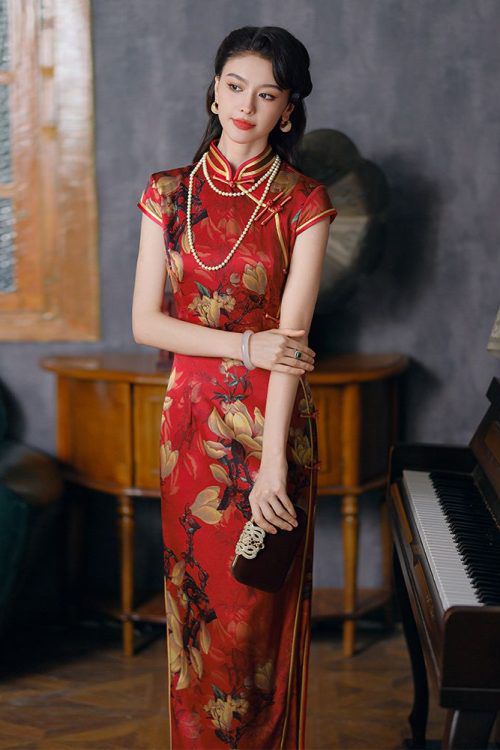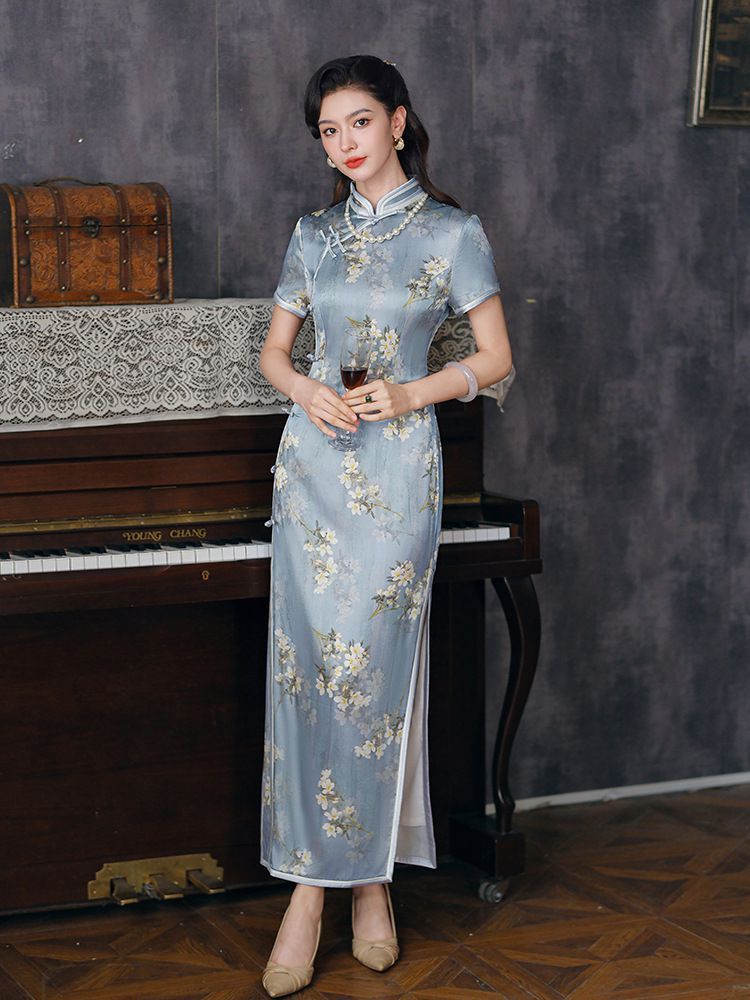Itu Qipao merah: A Symbol of Luck, Prosperity, and Joy
The qipao, a traditional Chinese gaun, is renowned for its vibrant colors and intricate designs. Each hue carries a profound symbolic meaning, reflecting the wearer’s aspirations and cultural heritage. Among the most iconic colors is merah, a vibrant shade that has captivated generations.

Cultural Significance of Red
Red, in Chinese culture, symbolizes luck, prosperity, and joy. It is associated with auspicious occasions such as weddings, festivals, and the Chinese New Year. The red qipao, therefore, embodies these positive attributes, making it a popular choice for celebratory events.
Protective Qualities
The color red is also believed to ward off evil spirits and bring good fortune. In ancient China, red was used to decorate homes and temples to protect against negative energies. By wearing a red qipao, individuals hoped to attract good luck and ward off misfortune.
Expression of Femininity
Furthermore, red is associated with passion, love, and romance. The red qipao has become a symbol of femininity and allure, often worn by women to express their confidence and desirability. The vibrant hue draws attention and commands respect, making it a statement piece in any wardrobe.
Modern Fashion Trends
In addition to its cultural significance, the red qipao has also gained popularity in the fashion world. Designers have embraced the vibrant shade, incorporating it into modern and contemporary designs. The red qipao has become a versatile garment, suitable for both formal and casual occasions.
Kesimpulan
Whether worn for a special celebration or as a fashion statement, the red qipao carries a rich symbolic meaning. It represents luck, prosperity, joy, and femininity. By donning this iconic garment, individuals not only embrace Chinese tradition but also express their personal style and aspirations.
Itu Qipao hijau: A Representation of Nature, Growth, and Harmony
The qipao, a traditional Chinese dress, is renowned for its vibrant colors and intricate designs. Each hue carries a profound symbolic meaning, reflecting the wearer’s personality, aspirations, and connection to the natural world. Among the myriad colors, hijau holds a special significance, embodying the essence of nature, growth, and harmony.

Connection to Nature
In Chinese culture, green is associated with the element of wood, representing vitality, prosperity, and new beginnings. The green qipao evokes the lush greenery of forests, the vibrant meadows, and the tranquil waters of lakes. It symbolizes the wearer’s connection to the natural world, fostering a sense of balance and serenity.
Aspirations for Growth
Moreover, green is often associated with growth and renewal. The qipao in this hue represents the wearer’s aspirations for personal and professional development. It signifies a desire for progress, abundance, and the realization of one’s full potential.
Harmony and Peace
Furthermore, green is considered a harmonious color, promoting peace and tranquility. The green qipao exudes an aura of calm and composure, making it an ideal choice for occasions that require a sense of balance and diplomacy. It fosters a harmonious environment, encouraging cooperation and understanding.
Practical Significance
In addition to its symbolic meaning, the green qipao also holds practical significance. The color is believed to have a cooling effect, making it a suitable choice for warm weather. Its versatility allows it to be paired with a wide range of accessories and footwear, creating a variety of elegant and sophisticated looks.
Kesimpulan
In conclusion, the green qipao is a captivating garment that embodies the essence of nature, growth, and harmony. Its vibrant hue reflects the wearer’s connection to the natural world, their aspirations for personal development, and their desire for peace and tranquility. Whether worn for formal occasions or everyday wear, the green qipao exudes an aura of elegance, sophistication, and profound symbolism.
Itu Qipao biru: A Reflection of Tranquility, Wisdom, and Serenity
The qipao, a traditional Chinese dress, is renowned for its vibrant colors and intricate designs. Each hue carries a profound symbolic meaning, reflecting the wearer’s personality, aspirations, and cultural heritage. Among the myriad colors, biru stands out as a symbol of tranquility, wisdom, and serenity.

Association with Water
In Chinese culture, blue is associated with the element of water, which represents calmness, fluidity, and adaptability. The blue qipao embodies these qualities, evoking a sense of peace and tranquility in the wearer. It is often worn during meditation or relaxation, as its soothing hue helps to calm the mind and promote inner harmony.
Symbol of Wisdom
Moreover, blue is considered a color of wisdom and knowledge. In ancient China, scholars and intellectuals were known to wear blue robes, as it was believed to enhance their cognitive abilities and promote clear thinking. The blue qipao, therefore, symbolizes the pursuit of knowledge and the desire for intellectual growth.
Serenity and Purity
Furthermore, blue is associated with serenity and purity. It is often used in religious ceremonies and rituals, as it represents the connection between the earthly realm and the divine. The blue qipao, with its ethereal hue, reflects the wearer’s spiritual aspirations and the search for inner peace.
Versatile Elegance
In addition to its symbolic meaning, the blue qipao is also a versatile and elegant garment. Its rich shade complements a wide range of skin tones and body types, making it a flattering choice for women of all ages. The blue qipao can be adorned with intricate embroidery, beading, or lace, adding a touch of sophistication and glamour to the overall look.
Timeless Appeal
Whether worn for its symbolic significance or its aesthetic appeal, the blue qipao remains a timeless and cherished garment in Chinese culture. It embodies the virtues of tranquility, wisdom, and serenity, while also showcasing the wearer’s unique style and personality.
